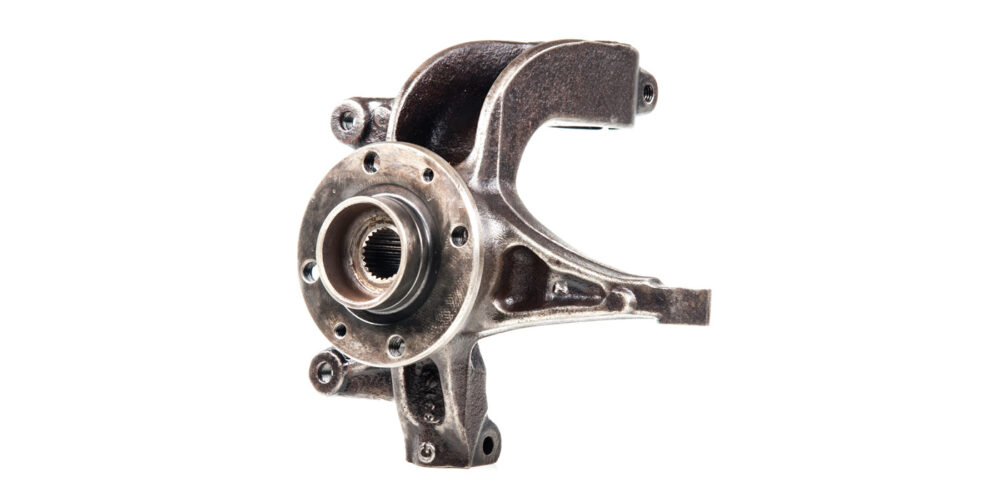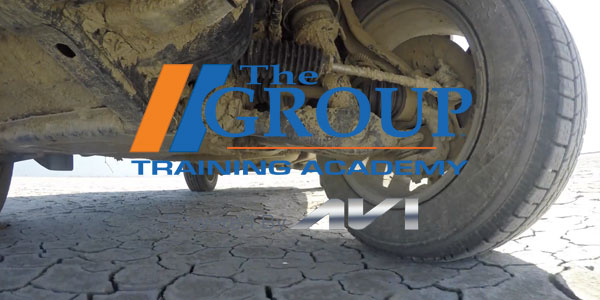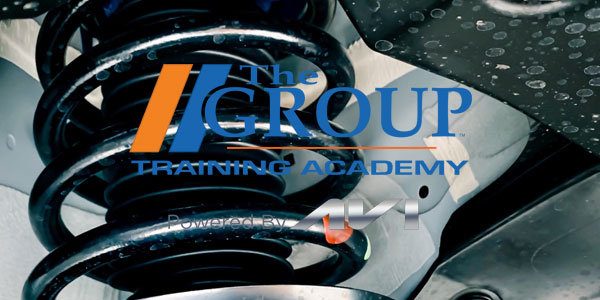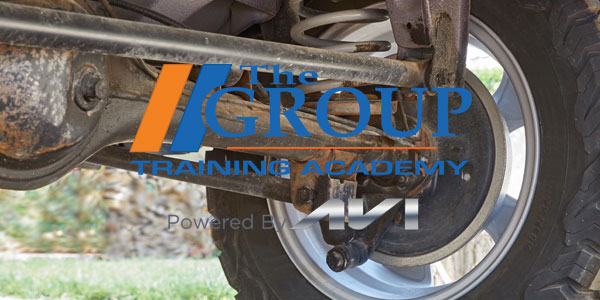The wheel bearings are the backbone of the vehicle suspension. They support the weight of the vehicle, help to keep the wheels in alignment and allow the wheels to rotate with as little friction as possible. But wheel bearings can’t do their job without a strong mounting point, and that’s the knuckle.
What Is the Knuckle?
The knuckle, also known as the spindle, is the suspension component that houses the wheel bearing, and the connection between the wheel and the suspension system. In the past, knuckles typically were made of steel, but today they’re more commonly made of aluminum or another lightweight alloy to save weight.
On the front of the vehicle, the knuckle will pivot on upper and lower pivot points as the driver turns the steering wheel, changing the direction the vehicle is traveling in. In the rear suspension, the knuckle won’t pivot, but instead will travel up and down. Any time you’re removing or replacing a wheel bearing, ball joint, tie-rod end or control arm, you’ll be working on a knuckle.
Since the wheel bearings and the knuckles work together, sometimes it will make more sense to replace them together. This type of assembly is referred to as a “loaded knuckle.” Why would a customer decide to install a loaded knuckle? In most cases, it comes down to one of two reasons: damage or time.
What Can Damage a Knuckle?
They can be damaged during a crash or a collision, or from violently striking a curb or a deep pothole. This type of damage can change the geometry of the suspension, causing a crooked steering wheel, wandering steering feel while travelling straight, or steering bind. If left alone long enough, it even can result in abnormal tire wear down the road.
A knuckle also can be damaged due to a failed CV axle or wheel bearing. In this case, I’m talking about a scenario in which a driver ignores the grinding, metal-on-metal noises from a failing wheel bearing, and continues to drive for a long, long time. I’ve seen this exact scenario in the shop before, and it usually isn’t pretty. Eventually, the wheel-bearing bore becomes deformed thanks to the added stress, and the entire knuckle is only good for scrap.
There’s one more thing that could damage a knuckle: overtightening a ball joint or tie-rod end. Ball joints and tie-rod ends usually feature a tapered seat, which becomes tighter as the fastener is tightened. In older knuckles that were made of steel, that tapered bore would hold up pretty well, even if the fastener was a bit overtightened. But the modern aluminum or alloy knuckles are much softer, and they’re susceptible to damage from over-tightening. If the joint is tightened down but it’s still loose inside the tapered bore, the bore is damaged and the entire knuckle will need to be replaced.
What About Time?
So, we know why a customer might replace a damaged knuckle, but what does time have to do with it? That’s easy: Time is money. This applies to both DIY and DIFM customers. DIY customers are trying to get their vehicle fixed and back on the road as quickly as possible, especially if it’s their one and only vehicle. DIFM customers are trying to maximize their efficiency, and keep the shop running smoothly. In either case, if the customer runs into trouble, the results can be costly.
This is especially prevalent with press-in wheel bearings. This type of bearing is quite labor-intensive to remove and replace. After years of exposure to road debris, grit and salt, they can become stuck in place inside the knuckle. In extreme cases, it could take more time and labor to remove and replace a press-in bearing versus simply replacing the whole thing with a loaded knuckle.
On vehicles with aluminum knuckles, you may find that corrosion will form around a pinch bolt, axle nut or snap ring. This corrosion can make it extremely difficult, if not impossible, to remove that fastener. At some point, it makes more sense from a time and money standpoint to simply replace the entire knuckle, rather than get bogged down trying to remove a stubborn fastener.
Advantages of Loaded Knuckles
First and foremost, the nicest thing about a loaded knuckle is that it comes to you pre-pressed, so there’s no need to press out the old bearing, clean everything up and press in the new bearing. There’s no second-guessing if you set the bearing or the hub to the correct depth, or if you inadvertently damaged something by applying too much force with the shop press. That is a huge advantage to the DIY customer who might not have the necessary tools for this type of repair. It’s also helpful to the DIFM customer as it allows them to manage their time much more efficiently.
Customers might think that they can save a little bit of money by only replacing a wheel bearing and reusing the steering knuckle. But those savings can go right out the window if they run into unforeseen troubles during the repair. If they end up damaging other components, or they spend more time than expected simply trying to remove the old bearing, it can spell disaster. DIY customers can end up being without their vehicle for longer than anticipated, and DIFM customers can lose out on other business if the vehicle is stuck on a lift for longer than anticipated.
Replacing the entire knuckle and bearing assembly at the same time reduces the likelihood of a customer comeback, and increases the chances of the repair being completed correctly the first time. Installing a loaded knuckle can reduce installation time by up to 75% depending on the application. Just like a loaded strut, a loaded knuckle can help to take the hassle and guesswork out of a potentially troublesome repair.













